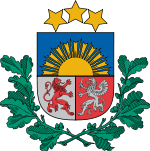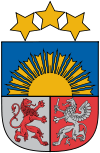- Coat of arms of Latvia
-
The Latvian national coat of arms was formed after the proclamation of an independent Republic of Latvia on November 18, 1918, and was officially adopted on June 16, 1921. It was especially created for its independent statehood. The national coat of arms combines symbols of Latvian national statehood, as well as symbols of ancient historical districts.
The sun in the upper part of the coat of arms symbolizes Latvian national statehood. A stylized depiction of the sun was used as a symbol of distinction and national identity by the Imperial Russian Army's Latvian Riflemen during World War I. During the war, the sun figure was fashioned with 17 rays that symbolized the 17 Latvian-inhabited districts. The three stars above the coat of arms embody the idea of the inclusion of historical districts (Vidzeme, Latgale and combined Courland-Semigalia (Kurzeme-Zemgale) into the united Latvia.
Culturally historical regions are also characterized by older heraldic figures, which already appeared in the 17th century. Courland and Semigalia (Western Latvia) are symbolized by a red lion, which appears as early as 1569 in the coat of arms of the former Duke of Courland and Semigalia. Vidzeme and Latgale (Eastern Latvia) are symbolized by the legendary winged silver creature with an eagle's head, a griffin. This symbol appeared in 1566, when the territories known today as Vidzeme and Latgale had come under Lithuanian control.
Base of the coat of arms is decorated with the branches of an oak tree, Quercus robur, which is one of Latvian national symbols.
The Latvian national coat of arms was designed by the Latvian artist Rihards Zariņš.
The proper use of the Latvian coat of arms is firmly regulated. Three types of symbol are used - the large coat of arms, the small enhanced coat of arms and the small coat of arms.
- The Large Coat of Arms is used by the President of Latvia, the Parliament, the Prime Minister, the Cabinet of Ministers, government ministries, the Supreme Court and Prosecutor General, as well as Latvian diplomatic and consular missions.
- The Small Enhanced Coat of Arms is used by the Parliament agencies, the Cabinet of Ministers and other institutions under direct or indirect supervision of the government ministries.
- The Small Coat of Arms is used by other government institutions, municipal authorities and educational institutions on official documents.
When Latvia was part of Soviet Union, the coat of arms of the Latvian SSR was used; this was replaced by the 1918 arms again in 1990.
Colors
- Red - PANTONE 186C
- Green - PANTONE 340C
- Blue - PANTONE 286C
- Yellow - PANTONE 124C
- Golden - PANTONE 873C
- Silver - PANTONE 877C
- Grey - PANTONE 4C
- Black - PANTONE Black
See also
- Latvia
- The flag of Latvia
- National anthem of Latvia
- Freedom Monument (Riga)
External links
- The Coat of Arms (English) (French) (Latvian) (German) (Russian) (Spanish) (Chinese) (Estonian) – basic info at the Latvijas institūts website
Coats of arms of Europe Sovereign
states- Albania
- Andorra
- Armenia
- Austria
- Azerbaijan
- Belarus
- Belgium
- Bosnia and Herzegovina
- Bulgaria
- Croatia
- Cyprus
- Czech Republic
- Denmark
- Estonia
- Finland
- France
- Georgia
- Germany
- Greece
- Hungary
- Iceland
- Ireland
- Italy
- Kazakhstan
- Latvia
- Liechtenstein
- Lithuania
- Luxembourg
- Macedonia
- Malta
- Moldova
- Monaco
- Montenegro
- Netherlands
- Norway
- Poland
- Portugal
- Romania
- Russia
- San Marino
- Serbia
- Slovakia
- Slovenia
- Spain
- Sweden
- Switzerland
- Turkey
- Ukraine
- United Kingdom
- (England
- Northern Ireland
- Scotland
- Wales)
- Vatican City
States with limited
recognition- Abkhazia
- Kosovo
- Nagorno-Karabakh
- Northern Cyprus
- South Ossetia
- Transnistria
Dependencies
and other territories- Åland
- Faroe Islands
- Gibraltar
- Guernsey
- Jan Mayen
- Jersey
- Isle of Man
- Svalbard
Other entities Categories:- National symbols of Latvia
- National coats of arms
- History of Latvia
Wikimedia Foundation. 2010.



